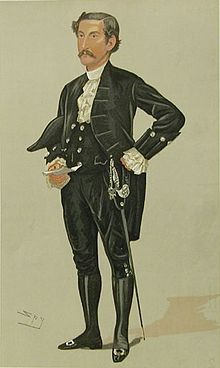
Sir Harry Seymour Foster (29 April 1855 - 20 June 1938) was a British Conservative Party politician who served as a Member of Parliament (MP) for three non-consecutive periods between 1892 and 1929.
He was the second son of Samuel Green Foster of London.
He was a Justice of the Peace and Deputy Lieutenant for Suffolk, and in the Commission of Lieutenancy for the City of London, where he was appointed a Sheriff of London for 1891. He was Consul-General of Persia from 1892 to 1923.

He was elected at the 1892 general election as MP for the Lowestoft division of Suffolk. He was re-elected in 1895, but did not defend his seat at the general election in 1900. He stood again at the January 1910 election, regaining the seat from the Edward Beauchamp, the Liberal who had won it in 1906. Foster's return to the House of Commons was short, as Beauchamp retook the seat at the December 1910 election.
After his defeat in 1910, Foster did not stand again until the 1924 general election, when he was selected as the Conservative candidate to replace Sir Thomas Bramsdon in Portsmouth Central. He won the seat, but stood down from Parliament at the 1929 general election.
He was a party in Foster v Driscoll 1 KB 470 involving a contract for the supply of whisky to the US during the prohibition era. The English courts refused to enforce the contract (even though governed by and lawful under English law), as its performance was unlawful under the law of the place of intended performance.
He married Amy, the daughter of John Sparks of Eastbourne and had 3 sons and 3 daughters.
References
- "House of Commons constituencies beginning with "P" (part 2)". Leigh Rayment's House of Commons page. Archived from the original on 27 November 2018. Retrieved 28 April 2009.
- ^ Fox-Davies, arthur. Armorial families : a directory of gentlemen of coat-armour. p. 504.
- Craig, F. W. S. (1989) . British parliamentary election results 1885–1918 (2nd ed.). Chichester: Parliamentary Research Services. p. 392. ISBN 0-900178-27-2.
- Craig, F. W. S. (1983) . British parliamentary election results 1918–1949 (3rd ed.). Chichester: Parliamentary Research Services. p. 217. ISBN 0-900178-06-X.
- "Archived copy" (PDF). Archived from the original (PDF) on 3 March 2016. Retrieved 3 May 2016.
{{cite web}}: CS1 maint: archived copy as title (link)
External links
| Parliament of the United Kingdom | ||
|---|---|---|
| Preceded bySir Savile Crossley | Member of Parliament for Lowestoft 1892–1900 |
Succeeded byFrancis Lucas |
| Preceded byEdward Beauchamp | Member of Parliament for Lowestoft January 1910 – December 1910 |
Succeeded bySir Edward Beauchamp |
| Preceded bySir Thomas Bramsdon | Member of Parliament for Portsmouth Central 1924–1929 |
Succeeded byGlenvil Hall |
This article about a Conservative Member of the Parliament of the United Kingdom representing an English constituency and born in the 1850s is a stub. You can help Misplaced Pages by expanding it. |
- 1855 births
- 1938 deaths
- Deputy lieutenants of Suffolk
- Conservative Party (UK) MPs for English constituencies
- UK MPs 1892–1895
- UK MPs 1895–1900
- UK MPs 1910
- UK MPs 1924–1929
- Sheriffs of the City of London
- Members of London County Council
- Members of the London School Board
- Conservative MP for England, 1850s birth stubs